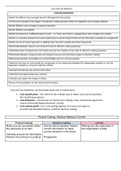International Business Context
University of Amsterdam
Exam Document
Contains:
Articles (headers)
Key points (bullets)
For every week.
*Link between weeks/concepts provided in final page.
1
, 1. Internalization theory
a. Buckley & Casson ‘The future of the MNE’ (1976) founding piece
i. Internal markets (MNEs) are created using locational choices of
(industry-, region-, nation-, firm-specific-) factors and knowledge
as a public good within the firm (risks of R&D: usefulness, time-
lag, imitation) to maximize profit and to bypass (built on TCE 1:
external) 5 types of intermediate product imperfections, such as
time-lag, discriminatory pricing, instability, knowledge
asymmetry and government intervention.
ii. Basic assumption of internalization theory (what constructs a
firm) internalization theory views a firm as a profit
maximization producing function in an imperfect market.
iii. Research objective internalization theory to explain the
emergence and expansion of multinational enterprises across
countries.
iv. Underlying logics of internalization theory IT is built on TCE
and argues that a firm will internalize a transaction when the
cost in the market is higher (when the cost of doing business at
arm’s length are higher than costs of internalization). This is
impacted by contextual (industry-, nation-, region-specific)
factors as they define the boundaries of the firm and its
interaction with the external environment. Internalization is the
optimized bundle of transaction costs.
b. Narula et al ‘Applying and advancing internalization theory’ (2019)
review and future research
i. B&C (1976) stream states why MNEs exist (TCE:
external/context); Hennart stream states additional types of
transaction costs (measurements, enforcement, reputation)
anchored in bounded rationality and opportunistic behavior and
a “swollen middle” between market and hierarchy (a continuum
of hybrid forms from price-based coordination to internal
governance/hierarchy mechanism); Rugman stream focuses on
MNE firm-specific assets with resource-based view (RBV:
internal).
c. Dunning ‘Toward an eclectic theory of international production’
(1980) empirical tests.
1. Basic assumption about OLI framework (what constructs a
firm) OLI view one firm as a unique bundle of
ownership-specific advantages and location-specific
advantages.
2. Research objective OLI framework to explain through
what form a firm could enjoy two types of advantages
(internalize or not), so it is not necessarily across national
boundaries.
3. Underlying logics of OLI framework that a firm will
internalize a transaction when the cost in the market is
higher, could be one of the mechanisms of the OLI
paradigm. However, OLI also recognizes other
mechanisms for internalization decisions such as
managerial goals and resource isolating. For instance,
1
TCE = profit maximization with transaction costs.
2
University of Amsterdam
Exam Document
Contains:
Articles (headers)
Key points (bullets)
For every week.
*Link between weeks/concepts provided in final page.
1
, 1. Internalization theory
a. Buckley & Casson ‘The future of the MNE’ (1976) founding piece
i. Internal markets (MNEs) are created using locational choices of
(industry-, region-, nation-, firm-specific-) factors and knowledge
as a public good within the firm (risks of R&D: usefulness, time-
lag, imitation) to maximize profit and to bypass (built on TCE 1:
external) 5 types of intermediate product imperfections, such as
time-lag, discriminatory pricing, instability, knowledge
asymmetry and government intervention.
ii. Basic assumption of internalization theory (what constructs a
firm) internalization theory views a firm as a profit
maximization producing function in an imperfect market.
iii. Research objective internalization theory to explain the
emergence and expansion of multinational enterprises across
countries.
iv. Underlying logics of internalization theory IT is built on TCE
and argues that a firm will internalize a transaction when the
cost in the market is higher (when the cost of doing business at
arm’s length are higher than costs of internalization). This is
impacted by contextual (industry-, nation-, region-specific)
factors as they define the boundaries of the firm and its
interaction with the external environment. Internalization is the
optimized bundle of transaction costs.
b. Narula et al ‘Applying and advancing internalization theory’ (2019)
review and future research
i. B&C (1976) stream states why MNEs exist (TCE:
external/context); Hennart stream states additional types of
transaction costs (measurements, enforcement, reputation)
anchored in bounded rationality and opportunistic behavior and
a “swollen middle” between market and hierarchy (a continuum
of hybrid forms from price-based coordination to internal
governance/hierarchy mechanism); Rugman stream focuses on
MNE firm-specific assets with resource-based view (RBV:
internal).
c. Dunning ‘Toward an eclectic theory of international production’
(1980) empirical tests.
1. Basic assumption about OLI framework (what constructs a
firm) OLI view one firm as a unique bundle of
ownership-specific advantages and location-specific
advantages.
2. Research objective OLI framework to explain through
what form a firm could enjoy two types of advantages
(internalize or not), so it is not necessarily across national
boundaries.
3. Underlying logics of OLI framework that a firm will
internalize a transaction when the cost in the market is
higher, could be one of the mechanisms of the OLI
paradigm. However, OLI also recognizes other
mechanisms for internalization decisions such as
managerial goals and resource isolating. For instance,
1
TCE = profit maximization with transaction costs.
2










